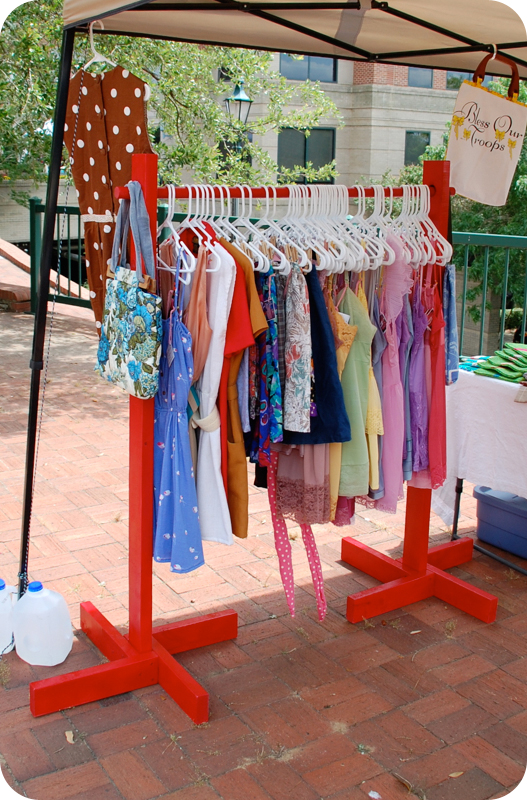Sewing Machine Diagram
As friends of mine start to dive more into sewing, and I refer them to my tutorials, I hear the helpful constructive criticism that I never started at the beginning, for novice sewers. So here it is. A diagram of a sewing machine to help you get to know your machine. This diagram may, and probably does, vary slightly from your machine, since this Singer of mine is older, but they're all pretty similar. The stitch selectors may be round knobs, the reverse in the center of one of them. The power switch is probably on the side. Bobbin may not be a drop down. Presser foot lever is probably on the side of the presser foot, while this machine's is on the back side. But you get the idea.
Read the explanation below of all of the parts to help you get started...
Parts:
Balance Wheel: the crank wheel on the side of the machine that moves the needle up and down. Also commonly refered to as the hand wheel.
Bobbin winder: this is where you make your bobbins. Place source thread on the spool pin, and feed the thread through a thread guide on the top and back to the empty bobbin. Push bobbin in towards winder until it clicks. *Usually* this will disengage your machine's needle from going up and down. If it doesn't, try pulling OUT on your balance wheel.
Spool Pin: This is where your spool of thread goes. Thread your machine starting here!
Tension Control: This is the control for the tension of your machine. Read your manual and adjust this only when necessary. Most machine have automatic tension settings. A good way to check your tension is to sew white fabric with a red bobbin and blue upper thread (or just difference color thread from the color of your bobbin). Sew the fabric. If you see the red come through to the top, your tension is too high, too tight, and if the blue thread show through the bottom, it is too low, too loose.
Upper Tension Regulator: Your thread passes through this and this is how the tension control is applied to your thread. Thread your machine with your presser foot lever up. This opens the disks in the upper tension regulator. When your presser foot is down, you will notice the tension pulling back, when you tug on the thread.
Thread Guides: Thread passes through these when threaded through the machine.
Thread Take Up Lever: The take up lever coordinates with the timing of the needle, lever up, needle is up. Thread passes through this and prevents thread from wadding up when you are sewing. Older machine may require you to actually thread it through a hole, with newer machines having a slot.
Presser Foot: The presser foot exerts pressure on the fabric as it is pushed under the needle. You machine will have the option to change out the KIND of presser foot with special attachments for all kinds of sewing. i.e. zipper foot, rolled hem foot, button hole foot. There are all kinds of amazing and fun attachments. Don't just limit yourself to the one on your machine.
Presser Foot Lever: Lifts and lowers the presser foot. Lift up when threading machine.
Throat Plate: The metal plate beneath the presser foot. Will have useful thread guides for when you are sewing. It is removable for dusting and cleaning your machine, and also covers the bobbin and bobbin case.
Feed Dogs: The teeth that feed the fabric through your machine. These feed dogs also control the stitch length and how fast the fabric is fed through the machine. DO NOT pull or push your fabric when you are sewing, let the feed dogs do all the work to prevent breaking a needle.
Bobbin Case and Housing: This is where your bobbin and bobbin case are. Be sure to thread your bobbin case properly. This will vary by machine.
Stitch Length Regulator: The length of your stitch. The number of stitches per inch is generally what the numbers reflect.
Stitch Selectors: Switch between straight, zig zag, and other embroidery and stretch stitches depending on what you are sewing.
Reverse: Lock your stitch in place by sewing a few stitches in reverse at the beginning and end of your seams. While pressing down on the pedal, push in reverse. Some newer machine may not require you to press down on the pedal.
More novice sewing lessons coming soon!



you are awesome!!! this is very helpful to those of us who are JUST beginning!!!
ReplyDeleteKnowing your machine is so important, to both novice sewers and experienced ones. Thanks Sally!
ReplyDeleteThis is an awesome post! I'm not sure how I got directed to your page, but I'm SO GLAD I found your blog!
ReplyDelete
ReplyDeleteOak Rose Mama, I'm with you! Alas, I'm expecting a third boy; but had I a girl, I would be a blue and red gingham kind of mom myself.
embroidery machine reviews